A Police Officer's Remembrances of Old Ancker Hospital1
by Edward J. Steenberg2
Saint Paul Police Historical Society
A few months back I was contacted by the daughter of a former neighbor asking about my recollections of old Ancker Hospital located in the West Seventh neighborhood of Saint Paul. As I put pen to paper I realized that no discussion of Ancker Hospital could take place without bringing up the founding of its predecessor, City & County Hospital, as well as all of its successors. And as a former police officer, I would also have to reflect on the city's emergency medical service, old and new, as well as the hospital's lockup/lockdown capability, and the morgue. Those were significant elements of my memories of old Ancker Hospital. The narrative kept getting longer, as I added photographs and commentary of colleagues, and for this, Ann, you are to blame.
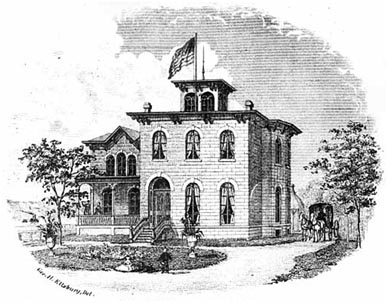
City & County Hospital (c. 1873)
The Ramsey County Board of Control of Public Charities (changed by state legislative action in 1897 to the "Ramsey County Board of Commissioners") was organized on July 22, 1872, to direct the Alms House, General Hospital, and other charitable endeavors of Ramsey County. That same year, the Board of Control authorized the purchase of an old stone ten-room mansion built in about 1857 for Alexander Vance Brown3 in the West End (West 7th/Fort Road) neighborhood of Saint Paul for $20,000. The property was to be used as a hospital for the general public and indigent. It contained no indoor plumbing and water had to be hauled in by bucket from an outdoor well. Kerosene lamps supplied light and each room had its own fireplace or stove.
The City & County Hospital was officially established on that site the following year, and by that summer the first patients were being treated in Brown's old stone mansion. Prior to that purchase, the mansion served as a private hospital under the ownership of Jacob H. Stewart MD4, one of Saint Paul's most prominent physicians, three-term mayor (Stewart was mayor at the time of the aforementioned purchase), county medical officer, and US Congressman, who had advocated for the establishment of a city, or "general" hospital. Dr. Stewart and his son-in-law, Dr. Charles A. Wheaton5, were both appointed to the office of City Physician and Health Officer and ran the new City & County Hospital during those early years. A new Superintendent/Physician/Surgeon-in-Charge, Dr. Arthur B. Ancker6, was elected (hired) by the board in August of 1883. An act was approved by the state on January 31, 1887, authorizing the city to issue bonds in the amount of $50,000 to construct additional buildings as needed, and the state further recognized the entire operation by way of legislative consent on February 22, 1889, and an appropriation of $100,000 for the purchase of additional land. An "elegant" new wing was constructed and opened to the public in November of 1895.
The facility was renamed the Arthur B. Ancker Memorial Hospital in honor of that first superintendent, upon his death in 1923. Over the ensuing years it grew to encompass twelve buildings over several acres, with a mailing address of 495 Jefferson Avenue (corner of Jefferson Avenue and Colborne Street). In its prime, Ancker Hospital was acknowledged to be one of the largest and best medical services west of Chicago. In 1965, the patients of the old Ancker Hospital were moved to a new seventeen million dollar campus at 640 Jackson Street (corner of Jackson Street and University Avenue), in the North Lowertown neighborhood of Saint Paul, near the Minnesota State Capitol building, and the facility was renamed Saint Paul Ramsey Hospital. It was renamed again in 1977 as the Saint Paul-Ramsey Medical Center, and in 1986 the hospital became a private, nonprofit facility, and was no longer county-operated. In 1993 it merged with HealthPartners, and in 1997 it was renamed, again, as Regions Hospital. The old Ancker campus was completely demolished in 1967 and replaced by the headquarters of the Saint Paul school system (360 Colborne St.).
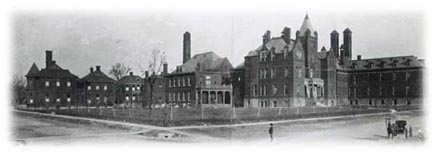
City & County Hospital, later to be the Arthur B. Ancker Memorial Hospital (c. 1900)

(c. 1910's)
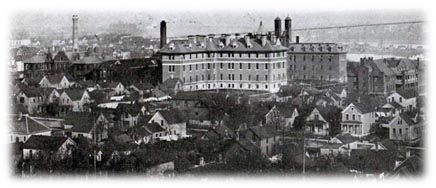
(c. 1912)
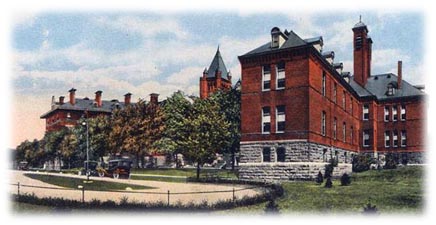
(c. 1915)
The Ancker Hospital holdings included a nursing school (tea was served at 10:00 a.m. by the student nurses), along with a dispensary for walk-in patients, a morgue and mortuary, as well as the "Foundling's Home" and facilities for several other medical disciplines. For the purpose of efficiency, most of the buildings were connected by tunnels. The campus was situated near a busy railroad crossing on West Seventh near Grace Streets, which was always a problem with ambulances and squad cars needing to get to the hospital as quickly as possible. Although many ghastly train-car wrecks occurred at the "Short Line" crossing, pleas for a grade separation went unheeded, ironically, until after the hospital moved to its new location east of the State Capitol. One of the most gruesome of incidents at the crossing was actually a railroad switching accident wherein a switchman 'cut' a stopped train at the crossing to allow vehicular traffic to cross in compliance with the city ordinance twenty minute mandate. When he went to reattach the cars he failed to step out of the way fast enough and the coupling took place... through his abdomen. Former Police Captain Larry McDonald7 recalls patients dying in the back seat of the police ambulance, while stalled at the "Short Line" crossing. Other retirees as well, remember similar situations involving children being born in the back seat of squad cars, or even officers falling asleep during the midnight shift, waiting in the queue for the train to move.
Today when traveling out West Seventh Street you drive up and over the aforementioned crossing on what is often called a "flyover", from about Saint Clair to about Jefferson Avenues. It's like driving up a long hill, and down the other side... over the railroad tracks. But that didn't resolve the problem of slow moving trains being an attractive nuisance for youngsters trying to hitch a ride or to cross the tracks that run through the now divided West End neighborhood. One night I had to respond as a street supervisor to a call wherein a young boy attempted to hitch a ride home... but failed. His father found the body, mangled (L-decollori), when he didn't return home at the assigned time.
As a side note, several of my colleagues from the police department married nurses who worked at Ancker and/or Saint Paul Ramsey Hospital. Same rotating shifts and frequent interface brought about common association. My own wife was a registered nurse, employed at Saint Paul Ramsey.
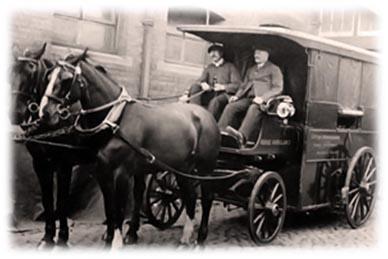
Horse Drawn Police Ambulance (c. 1902)
The city of Saint Paul through its police department got into the emergency ambulance service back on September 12, 1902, during the first term of Chief of Police John J. O'Connor8, with the purchase of a richly upholstered horse drawn wagon, lighted with electric lamps, and ready at a moment's notice to respond to a call in any part of the city... obtained from monies collected from a Saint Paul-Minneapolis Police benefit baseball game. Medical doctors rode in the wagon pulled by a gray team ("Queen" & "Dan"), and were available 24/7. Said ambulance made its first official run on November 1, 1902, with Doctor George B. Moore9 in charge. The teamster (driver) was Patrolman Patrick J. Casey10. The Minneapolis Police Department installed a system of like kind, five years later; putting same into operation in the fall of 1907. It was said that Saint Paul's police ambulance system was the first of its kind, west of Chicago.
In 1913 or early spring of 1914, during the terms of Chief of Police Michael Gebhardt11 (first term) and John J. O'Connor (second term), the familiar horse drawn police ambulance with over a decade of faithful service, was replaced by a motorized unit, possibly based upon a design developed by Dr. Arthur B. Ancker, himself, and utilized by Ancker Hospital. The motorized police ambulance was backed up by emergency cars (no physician). On December 1, 1967, during the term of Chief of Police Richard H. Rowan12, after sixty-five years of service, the police ambulance with attending physician was discontinued. The medical service would continue with five emergency cars, as well as station wagons with stretchers. Fifty percent of the city's marked squads were then station wagons. On July 15, 1971, the city's emergency medical services were transferred from the police department to the fire department in a budget exchange, where it now resides (paramedics). Two things predicated the move. The police department was overloaded with work, due to the times. A number of events, including anti-war demonstration and race riots, were taking place across the country which increased the call load for municipal policing, including Saint Paul. At the same time, work at the fire departments was changing as well. With updated state and municipal fire codes bringing about stand-pipes and sprinkler systems in the larger buildings, firefighters were finding fewer fires to put out. You can only train and polish trucks for so long. In Saint Paul it looked like serious layoffs on the fire side, while the police officers were running from call to call. It was a win/win situation for both agencies. Today, a vast majority of the fire department 'runs' are medical related.
The City & County Hospital and its successors had a very good working relationship with the police department, which continues to this day. Not only did they provide us with able physicians willing to work on our ambulances, but they allowed us to make purchases of first-aid and other like supplies from their bid contracts. Considering the economy of numbers, that provided the police department with quite a financial savings. The driver of the first motorized police ambulance was Chauffer (later Patrolman) Charles E. Oliver13. The driver of the last, Patrolman Harold D. Harrington, Jr.14
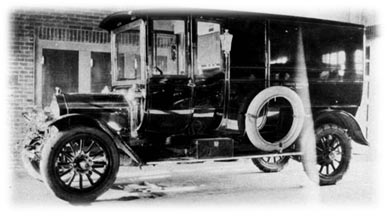
Saint Paul's First Motorized Police Ambulance (c. 1913)
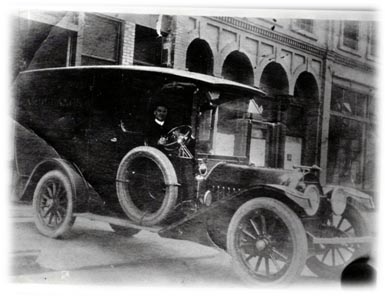
Police Chauffeur Charles E. Oliver w/Police Ambulance (c. 1913)
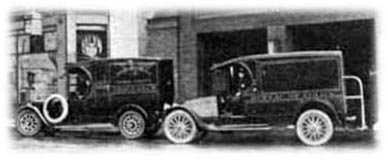
Police Ambulance & Emergency Car (c. 1915)
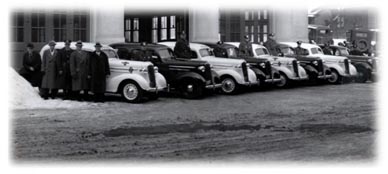
Police Ambulances in Front of Public Safety Building (March 9, 1936)
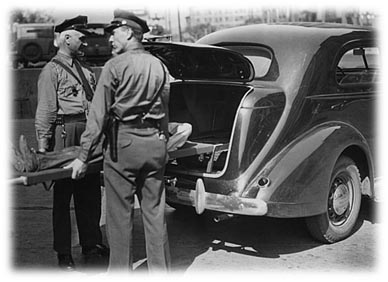
Officers Charles E. Oliver & William F. Proetz
w/Police Squad/Ambulance Conversion (c. 1937)
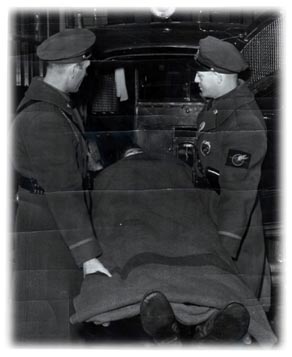
Officers Joseph A. Wimmer & Albert F. Ferguson "Load 'em Up" (March 1, 1941)
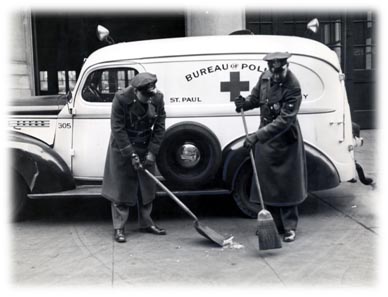
Police Emergency Squad (c. 1942)
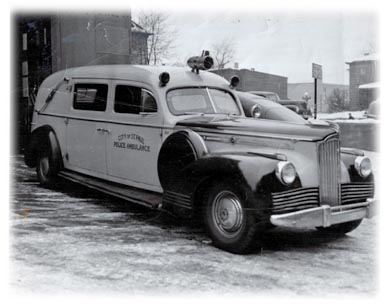
Police Ambulance (January 3, 1946)
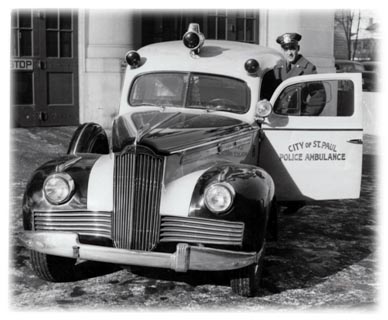
Anthony T. "Tony" Strecker w/Police Ambulance (February 4, 1947)
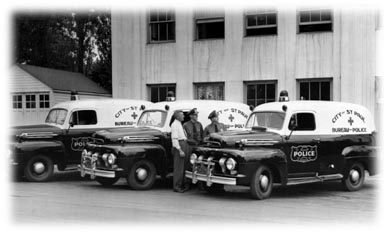
Police Emergency Cars (c. 1952)
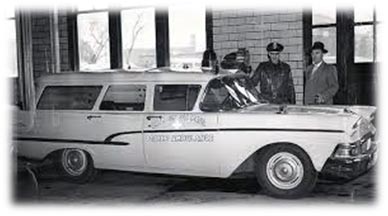
Lt. Donald T. Wallace & Chief William F. Proetz w/Police Ambulance (c. 1958)
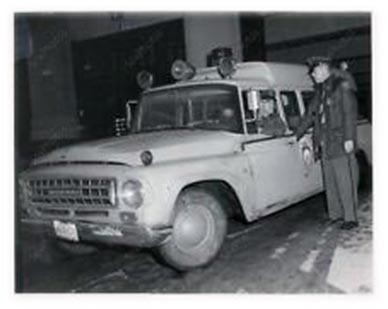
Officers Harold D. Harrington & William R. Miske
"The Last Tour of the Police Ambulance"
(Thursday, November 30, 1967)
My personal recollections of old Ancker Hospital is based on my appointment as a city patrolman in 1964. During that era the police department was still providing for the city's emergency ambulance service. The ambulance was housed in the Public Safety Building, a three story, low-rise, neo-classic, limestone structure, built in 1930 at 101 East Tenth Street (address later changed to 100 East Eleventh Street). An apartment was likewise provided in the Public Safety Building for attending physicians, most of whom were interns or resident physicians from Ancker Hospital... although some were in private practice. Police officers were drivers of the ambulance, and when no doctors were available another officer donned the white smock and carried the black bag. No one knew the difference. Many of the squads patrolling the streets of the city were station wagons. If the ambulance was busy on a run, the station wagons carried portable stretchers and could be utilized as necessary. As a young street officer, the job of ambulance driver was not one of my favorite assignments. You don't get much action sitting in a small room off the garage waiting for the clapper to ring the big brass bell.

Wall Mounted Alarm Bell (c. 1930-1971)
One positive result of my experience as an ambulance driver was that one of the young doctors that worked the Police Ambulance function, Rodney E. England MD15, became my Primary Care Physician from 1970, when my own doctor retired, to 2002 when Dr. England retired.
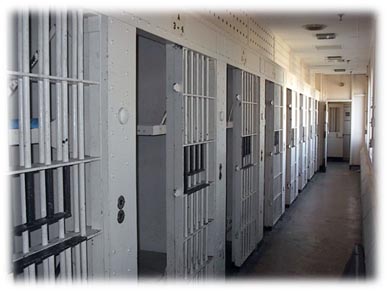
Saint Paul City Jail at the Public Safety Building (c. 1930-1972)
[Note the steel door of "solitary confinement" at the end of the hall]
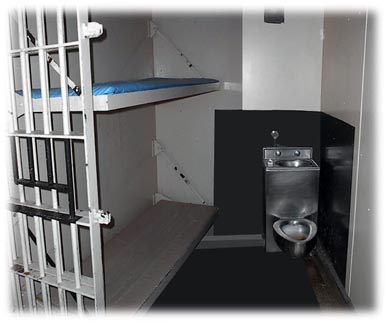
5' x 6.8' Standard Jail Cell (c. 1930-1972)
Also during that era, the police department was responsible for its own lockup (City Jail), located in the Public Safety Building. The Public Safety Building and jail had been planned and built in 1929-30, during the terms of Chief of Police Edward J. Murnane16, Thomas E. Dahill17 and Thomas A. Brown18. The jailers were city patrolmen and if any of their wards were hospitalized at Ancker Hospital, it was the responsibility of the city to provide for security within that medical setting. In that there was no lockup (patient/prisoner security) section within the hospital, that meant uniformed police officers had to sit outside the prisoner's room 24/7, just like on T.V. Again, that was not one of my favorite assignments.
Almost a century old, the halls were long and narrow with doors opening on either side. There was a medicinal odor that I associate with either or other nasal abomination... and a clothespin on one's nose was not a part of the police officer's uniform attire. At night, it was dark and dungy, and the hours dragged on. And in that there was no lockdown (outside interlopers) procedure in place, we always said that you didn't know if the rat coming down the hall was two-legged or four. The Ramsey County Sheriff's Department took over the operations of the city jail on April 26, 1972, relieving the Saint Paul officers of that responsibility. And by that time Saint Paul Ramsey Hospital had been built, with a secure area for prisoners.
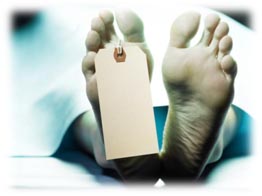
Infamous Toe Tag
My third reason for visiting the Ancker Hospital campus on a regular basis was because that is where the old morgue was located... a place where the deceased are kept until autopsies are conducted to determine cause of death, or until the body is identified and claimed by family or released for burial. Although I have not been able to identify the location of the official Ramsey County Morgue19 at the time the City and County Hospital was built, I do know that it was located at 164 South Washington Street in Saint Paul by 1887. When I came on the job, Ancker Hospital maintained its own morgue, but also worked as backup for the county morgue. As an example, when a gas explosion ripped apart three 3M buildings on Saint Paul's East Side on February 8, 1951, at least fifteen persons were killed and forty-nine injured. Half of the deceased were transported to the Ramsey County Morgue, and the other half to Ancker Hospital's morgue. Police investigations, evidence collection, and/or many other reasons required our presence at whichever location. Having been present for a number of autopsies at the old morgue, I can still associate with the smell of antiseptic cleansers... as well as the underlying odor of death and decomposition. And you knew that if the rat you saw coming down the hall (above) was four-legged, it was coming from the morgue.
As mentioned earlier, in its day, the Arthur B. Ancker Memorial Hospital was a class operation; it simply outlasted its use.
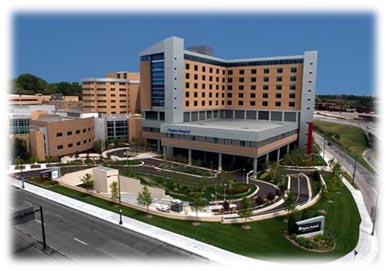
Regions Hospital (c. 2015)
1 For an extensive historical view of Ancker Hospital go to a 1987 Ramsey County Historical Society publication: Ramsey County History; Volume 22, Number 1; "Roots of Ramsey's Health Care Trace Back to Ancker Hospital", by Mary Alice Czerwonka.
2 Edward J. ("Ed") Steenberg was appointed a Saint Paul Patrolman on November 2, 1964. Rising up through the ranks to the position of Deputy Chief of Police, he retired as Senior Commander on July 2, 1999. Today, Steenberg is President of the Saint Paul Historical Society.
3 Alexander Vance Brown was a major real-estate speculator during the 1850s in St. Paul's West End. He was the original owner of the ten-room Jefferson Avenue stone mansion purchased by the county in 1872; nucleus of the City & County Hospital.
4 Jacob H. Stewart, MD was appointed Chief Medical Officer of Ramsey County in 1856; was appointed Surgeon General of the State of Minnesota from 1857-1863; was elected to the Minnesota State Senate from 1858-1859; during the American Civil War served as surgeon in the Union Army; was elected Mayor of the City of Saint Paul for three terms from 1864-1874; served as Postmaster of Saint Paul from 1865-1870; was elected to the US Congress from 1877-1879; served as Surveyor General of Minnesota from 1979-1982; and returned to his medical practice in Saint Paul until his death on August 25, 1884.
5 Charles A. Wheaton, MD, physician and surgeon, was son-in-law of Dr. Jacob H. Stewart. One of the first doctors at the City and County Hospital (1873), Wheaton was elected President of the Ramsey County Medical Society (1884), an office he held for many years.
6 Arthur B. Ancker, MD was appointed Superintendent/Physician/Surgeon-in-Charge of the City & County Hospital in 1883, and maintained those positions until his death on May 15, 1923. The name "City & County Hospital" was subsequently changed to the "Arthur B. Ancker Hospital Memorial Hospital" in his honor.
7 Laurence F. ("Larry") McDonald was appointed a Saint Paul Patrolman on July 11, 1955. Rising up through the ranks, he retired as a Police Captain on March 31, 1995. Today, McDonald is the Vice-President of the Saint Paul Police Historical Society.
8 John J. ("The Big Fellow") O'Connor was appointed Chief of Police on June 9, 1900, after nineteen years on the department, rising through the ranks including a period as Chief of Detectives. He resigned on February 29, 1912, to go into private business, but was re-appointed Chief of Police on June 2, 1914. He was the architect of the "O'Connor System" or layover agreement which guaranteed safe haven for "public enemies" visiting Saint Paul during the gangster era.
9 George B. Moore, MD was appointed Police Surgeon on November 1, 1902, and died on November 14, 1906, the only Police Surgeon to die while still employed by the department.
10 Patrick J. Casey was appointed Patrolman in May 1882; Resigned in May 1889; was re-appointed Patrolman on September 4, 1902; was assigned as Ambulance Driver on September 4, 1902; was re-assigned to Patrol Duty on August 1, 1914; and retired for pension on March 1, 1922.
11 Michael Gebhardt was appointed Chief of Police in 1913, after thirty years on the department, rising up through the ranks including a period as Police Captain. Although he was removed from office on June 2, 1914, this was just the first of several appointments of Gebhardt to the Office of the Chief.
12 Richard H. (Dick) Rowan was appointed Chief of Police on June 30, 1970, after twenty-three years on the department, rising up through the ranks including a period as Deputy Chief of Police. Chief Rowan retired on December 31, 1979.
13 Charles E. Oliver was appointed Police Chauffeur on February 26, 1913, to drive the department's first motorized ambulance. His title was later changed to Patrolman. He died on May 6, 1939, still primary driver of the ambulance.
14 Harold D. ("Snuffy") Harrington Jr. was appointed Patrolman on August 1, 1932. He was the relief ambulance driver from 1934 to 1957, and primary driver from 1957 to the end of the ambulance era in 1967. He continued to drive the "paddy wagon" until retirement on September 5, 1972.
15 Rodney E. England, MD was appointed Police Surgeon on July 22, 1957 and resigned on September 6, 1957 to go into the U.S. Military. He was Steenberg's Primary Care Physician for thirty-two years.
16 Edward J. Murnane was appointed Chief of Police on June 14, 1924, after ten years on the department, all within the Detective Division. He was granted a leave of absence from January 22 to June 1, 1930, at which time he resigned from office.
17 Thomas E. Dahill was appointed Acting Chief of Police on January 22, 1930, after nineteen years on the department, rising through the ranks including a period as Captain of Detectives, replacing Edward J. Murnane (above) who was on a leave of absence.
18 Thomas A. Brown, once a defendant in a Cleveland liquor syndicate case, was appointed Chief of Police on January 22, 1930, replacing Edward J. Murnane (above). He was dismissed as Chief on June 6, 1932, but later while head of the elite Police Kidnap Squad was suspected by the FBI of leaking information to members of the Dillinger and Barker-Karpis gangs and was removed from police service on October 9, 1936.
19 Records indicate that the Ramsey County Morgue was located at 164 South Washington Street (just up the hill from the docks of Upper Landing) in 1887. It moved to 155 Hill Street in about 1994, and what is now called the "Office of the Medical Examiner" relocated to 300 East University Avenue, near Regions Hospital, in about 1996. Coroner at time of the City and County Hospital startup was one Patrick McAvoy.
